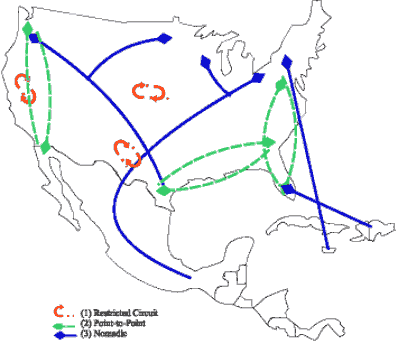Migration Patterns
To understand the MCN constituent stakeholder population, it is critical to understand that it is a mobile population, adding complexity to already difficult health concerns including environmental exposures. To compound the issue, migration itself is not always straightforward. Recent evidence points to the development of more complex patterns of movement. While most mobile workers move in pursuit of work, their patterns and length of migration can vary significantly. This map shows samples of general types of migration routes that currently exist. Numerous other routes exist that are not shown here.

Migration is changing the demographics of the United States in dramatic way. Latinos are now the largest minority group. The migrant population is growing at unprecedented rates and occurring in non-traditional receiving areas. For instance, from 1990 to 2000 the Hispanic population increased at a rate as high as 300% in parts of Lower Delaware and 200% in some jurisdictions on the Lower Eastern Shore of Maryland. A 2003 study of immigrants in this region showed that over half had arrived in the last two years. These immigrants are young, first time immigrants (have not been anywhere else in the United States), come from non-traditional sending states in Mexico such as Chiapas and Veracruz and work primarily in construction, agriculture and the poultry industry.
This community of immigrants is extremely isolated from social networks as well from social service and healthcare providers. These young, inexperienced immigrants are working in some of the most hazardous occupations. (Dunn, 2003). While the study focused on a small agricultural region, the changing face of migration in the studied area exemplifies what is occurring throughout the United States. It is critical that the health care community understand the nature of environmental exposures facing this growing, vulnerable population. It is essential that clinicians serving migrant communities receive the appropriate environmental medicine resources to address environmental hazards in both agriculture and the other high risks occupations.